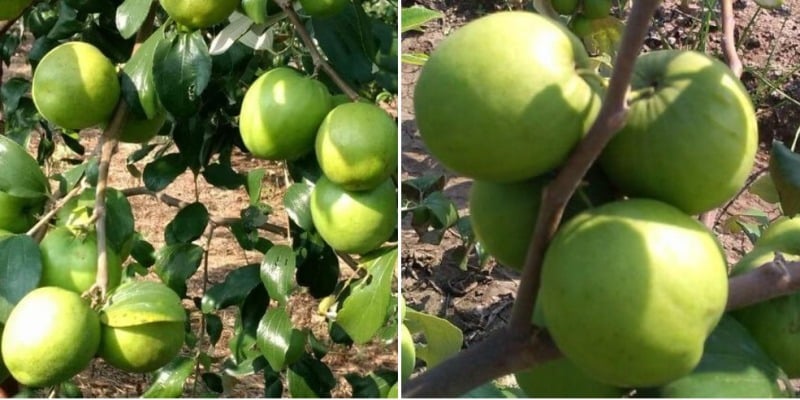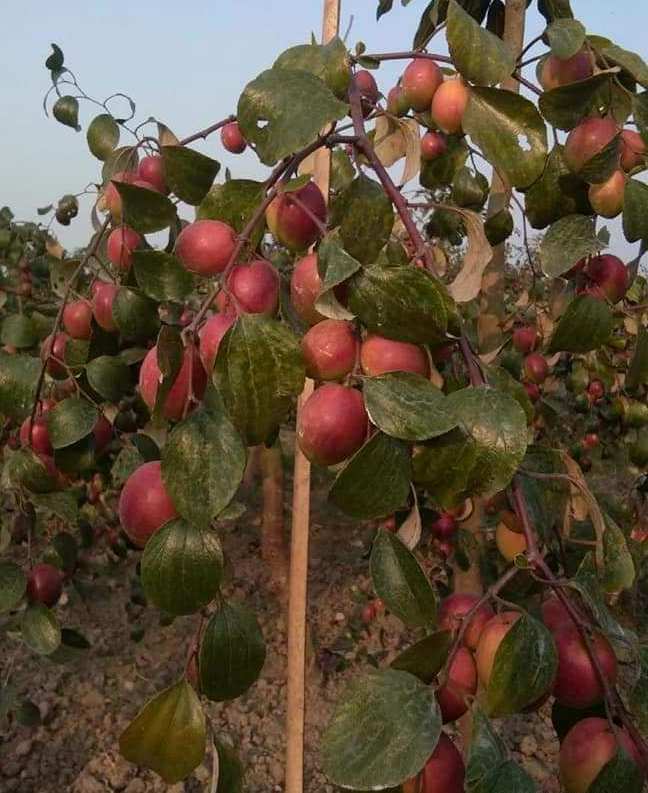A step by step guide for Apple ber cultivation income and the yield of apple ber
Today, we discuss the apple ber cultivation income along with the following:
- Profits Of Apple ber Cultivation
- Apple ber Farming Benefits
- Net Profits Of Apple ber
- Cost Of Cultivation Of Apple ber
- Apple ber Project Report in one acre
- Number of Apple ber Trees per acre
- Apple ber yield per tree and per acre
- Apple ber plant care
- Harvesting procedure of Apple ber tree
Apple ber fruit is a Thailand variety fruit and it is also known as the Indian jujube or Chinese date. The taste of this Apple ber fruit is Sweet, Crispy & Juicy. Apple ber cultivated areas in India are West Bengal, Telangana, Andhra Pradesh, and Maharashtra.
Apple ber cultivation practices:
Let us discuss the cultivation of Apple ber and its requirements;

- Normally, all types of soils are suitable for the cultivation of Apple ber.
- For the farming of Apple ber, the soil is highly acidic and low in organic matter content. For the cultivation of the Apple ber plant, the black soil is used and a 5-9 pH level is required.
- For best production, this ber fruit crop requires hot and dry climatic conditions. The Apple ber fruit crop tolerates high temperature and aridity by a cessation of growth, leaf fall, and dormancy stage.
- The best season for the Apple ber plantation is monsoon June to August and December to March.
- The Apple ber cultivation is gaining momentum in subtropical and tropical regions of India owing to its precocity in bearing, fruit size, yield potential, and crisp texture. A cultivation period of Apple ber plant in March – October.
- For the cultivation of Apple ber generally used in the plant stem. The sowing of the ber plant uses the square method for the plant sowing. 10 by 10 areas are generally used for the plant sowing.
- For the Apple ber plant irrigation, the drip irrigation method is mostly used, also hand to hand Irrigation is mostly used in these plants. In a week, seven-liter water is required for each plant.
- The plant life is about 20 years and can be propagated through seed and can be multiplied by cuttings of half-ripe wood. The cuttings should be 10 to 12 cm long and preferably with a heel. The cuttings are planted in July-August month and are easy to plant. Layering is feasible. Grafting by skilled professionals could deliver higher fruit yield.
- Natural Pollination is possible and this process is disease-free. This is germ resistant and the ber fruits have more shelf life. The price of ber fruits is higher when compared with any traditional fruit varieties. Two times the yield in a year and the crop time can be changed based on the market demand.
- Apple ber plants started bearing after one year of planting. Flowering started in the second fortnight of September and continued till October month. There were profuse flowering and a very high fruit set.
- Black polythene mulch is useful in conserving soil moisture and the growth of ber trees.
- Fruit attained maturity after 70 to 75 days of flowering. The Apple ber is generating more fruits in a current season tender branches on leaf axils. So periodic pruning help generate more new branches that in turn produce more flowers and fruits.
- Generally, Apple ber fruit weight comes with from 30gm to 120gm. This variety came to India about ten years ago. Apple ber fruit is very attractive to see.
You may also like Organic Food Cultivation.
Plant protection measures of apple ber:
Insect Pests of apple ber
Insect pests mostly observed in Apple ber are fruit fly, fruit borer, leaf-eating caterpillars, mealybug, scale insect, and thrips. The selection of healthy planting material and appropriate inter-cultural operations apart from the application of pesticides are effective in controlling the pests.
Diseases of apple ber
The main diseases in Apple ber reported are powdery mildew, leaf spot, rust, and black spot. Application of Kavach Rovral or Mancozole (2 g./l.)/wettable sulfur etc. depending on kind of infection is effective in most cases.
How and When to harvest apple ber fruits:
- Apple ber matures 150-175 days after flowering. Apple ber pre-harvest spray of 750 ppm. 2-chloroethyl phosphoric acid or ethephon induces early maturity. Fully mature fruits are harvested by picking which is generally done in the forenoon.
- Generally, harvesting of Apple ber fruits started in December. In one-year-old plants, the number of fruits varied 350 to 650, and fruit weight ranged between 35-55g. The size of Apple ber fruit and yield may increase with the regulation of fruit number and age of plants.
- The Apple ber harvesting time in southern India is October-November, December-March in Gujarat, January-March in Rajasthan, and during February-April in north India.
Grading:
Apple ber fruits are graded based on their size into large, medium, and small-sized ones. The damaged, over-ripe, unripe fruits are generally discarded.
Storage:
Pre-cooling of fruits at 100 C immediately after harvest increases the shelf life by about three days when subsequently stored at room temperature. The storage life of the Apple ber fruits can be prolonged to 30 to 40 days when stored at 30°C and 85-90% relative humidity.
It is not too late to check Organic Herbs Farming for Profits.
Apple ber cultivation income in 1-acre plantation
In the market, Apple ber fruit cost will be approximately 40 to 80 Rs per Kg.
In one acre land, the number of Apple Ber plants accommodated is 190 to 200 with 15 feet distance. For example, if there are 200 plants in one Acre and Apple ber tree gives 150 kg fruits from a single tree (on average). We have 200 Plant and assume we get only 150 kg from the tree then we will get a total of 30 tonnes fruits from 1 acre. Generally, Apple ber fruit is sold 40 to 80 Rs in the retail market but the farmer gets 15 to 20 Rs in his hands.
Suppose we sold at only 15 rupees per kg (According to demand for Apple ber in the market this is the lowest rate).
Total Net Profit in apple ber cultivation is 35,000 kg × 15 Rs.
The total income from 1 acre of apple ber cultivation is Rs. 5,25, 000\-
Total Expenditure (Maximum): 65,000/- Rs
The total profit an apple ber farmer can expect from the 1-acre cultivation is about Rs.4, 60,000/-
Farmers can earn up to Rs 5 lakh per annum from over 200 ber trees. The plant starts bearing fruits in 9 months and gives around two quintals of the fruit a year. Each plant will earn about Rs. 2250 per year.
The above-mentioned calculations are just for your reference and they keep changing by the time, region, and other factors.
You may be interested in Groundnut Oil Making Process.
The yield of apple ber per plant and per acre:

Generally, the Apple ber plant gives more fruit yield. A yield of Apple ber can be expected about one quintal of fruit in one apple plant. Therefore, this is the best yield for the farmer for income.
The average yield of Apple ber during the prime bearing period (10-20 years) ranges from 80 to 150 to 200 kg /tree (Expect a low yield of ber fruits during the first year). In dry areas, under rainfed conditions, 50 to 80 kg fruits/tree can be obtained. Trees remain productive for 25 to 30 years.
Note: The yield of apple ber depends on many factors such as soil fertility, climatic conditions, and cultivation practices.
That’s all folks about cultivation income of apple ber and the project report of apple ber farming. Good luck and keep farming!.
You may be interested in Growing Hydroponic Bitter Gourd.
How about the marketing of apple Ber fruit if I get Train on this, I will be having 10 acres of land in palmner taluk AP. So will plan as per
In summer it’s 45+ digress in my place. So is it possible to grow Apple?
No
Sir your content on Thai apple was very good and a lot came to my knowledge. Thanks. Sir, I am from Sikar district Rajasthan.I am interested in the cultivation of Thai apple. I will be highly obliged if you tell me where I can get authentic fruit plants near me.
Thanks for the useful information.
I have few queries kindly help –
I have 650 plants ( purchased from VNR ) & it’s 3rd year planted in Bhopal.
1. Do I have to keep all the branches or selective? my Ber size is small in this crop since I have kept all the branches.
2. Fruits suffered badly with fruit fly though controlled later …when should start pesticide?
3. I have started plucking fruits from 25th Dec ..how long I will get fruits.
Thanks & Regards
I have 6 acres of land an average temperature is 29 to 34 is it useful?
More than enough
I bought 100 apple ber seedlings for transplanting that in sandy loam soil. There is tube well for irrigation. I am maintaining seedlings in my nursery as yet. Plants in polymers are about 9 inches with flowering in some. When and how and in how much area I need to transplant them at my Research and Development Farm located in submountaneous area of Saharanpur U.P. Western U P in Northern India Subtropical area
Books of details information cultivation, furtigation, pest control and etc